

Agridisk
Egypt - Alexandria
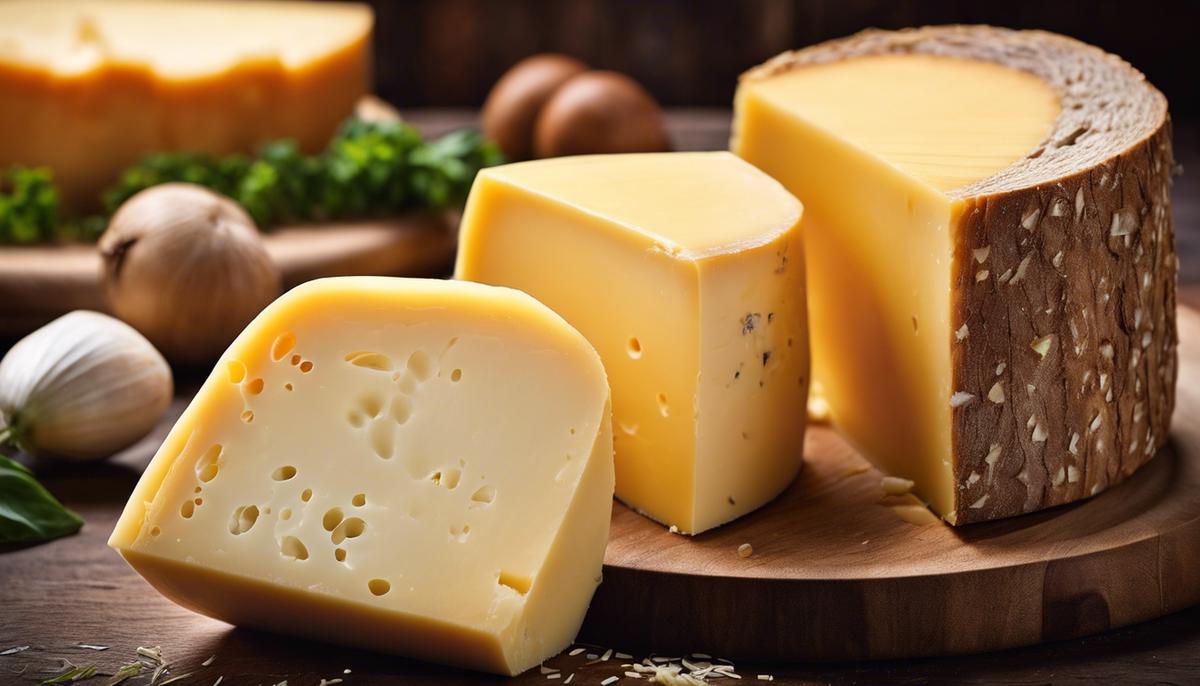
Gouda Cheese Nutrition Facts, Health Benefits, Process & Recipes
Description: When we think of comfort foods that tantalize our taste buds, few can rival the rich, creamy essence of Gouda cheese. This semi-hard cheese, originating from the Netherlands, has become a global favorite, admired not just for its smooth, buttery flavor, but also for its impressive nutritional profile. Whether melted over a crusty piece of bread or shaved atop a fresh salad, Gouda's versatility is as remarkable as its health benefits. In this exploration, we uncover the abundant nutritional merits of Gouda cheese. A veritable trove of protein, healthy fats, and essential vitamins and minerals, Gouda isn't just a culinary delight—it's a substantial contributor to a nutritious diet. We'll delve into every delicious detail, from the calorie count to the potent vitamin K2 content, revealing how this beloved cheese can support not only the quest for culinary excellence but also the pursuit of a balanced, health-conscious lifestyle. When it comes to indulging in cheeses, Gouda is a prime choice for those with a palate for rich flavors and a curiosity for nutritional bounty. Hailing from the Netherlands, this semi-hard cheese is not only a versatile ingredient in the kitchen but also a source of essential nutrients that benefit your health in more ways than one. Gouda is particularly noteworthy for its impressive calcium content, a mineral that is essential for strong bones and teeth. Just one ounce of Gouda can provide a substantial amount of your daily calcium needs, making it an excellent addition for anyone looking to shore up their skeletal health. And let's not forget about protein – this cheese packs a punch with a good dose, fueling your muscles and keeping those hunger pangs at bay. But the goodness of Gouda doesn't stop there. It's teeming with a variety of B-vitamins, most notably Vitamin B12, which is crucial for maintaining healthy nerve cells and creating DNA. Vitamin K2 can also be found in this cheese, a nutrient that's been linked to heart health and is believed to work alongside calcium to strengthen bones. What's more, Gouda contains a decent amount of healthy fats that not only contribute to its creamy texture but also support brain health. So next time you're nibbling on a slice of Gouda or melting it over a gratifyingly gooey dish, savor the delicious knowledge that you're also doing your body a favor. When it comes to taking kitchen creations to the next level, Gouda cheese is a secret weapon no culinary enthusiast should overlook. With its rich, buttery flavor and unparalleled melting properties, Gouda can transform the mundane into a gourmet experience. Envision a bubbling pot of fondue: substitute Gouda for the traditional cheeses, and suddenly there's a smooth, velvety dip that eagerly clings to crusty bread and crisp vegetables, or even drizzled over roasted potatoes, its decadent allure is irresistible. But Gouda's magic isn't confined to the fondue pot. Picture the classic grilled cheese sandwich, taken up a notch. Aged Gouda, with its pronounced nutty and caramel-like notes, layered between thick slices of artisan sourdough, griddled to golden perfection - it's a simple yet sophisticated twist on comfort food that will make tastebuds dance. Or consider the marriage of flavors in a pear and Gouda salad, where the ripe sweetness of the fruit is stunningly balanced by the savory depth of the cheese, all tied together with a glossy balsamic glaze for a delightful interplay of flavors. Don't forget, pairings extend beyond the plate. A glass of bold red wine alongside a platter of smoky Gouda can make for an unforgettable tasting experience. The robust tannins cutting through the creamy fat leaves a harmonious contrast on the palate. For beer aficionados, a malty ale with its caramel undertones complements Gouda's richness perfectly, making for a pairing that's both sophisticated and satisfyingly grounded. Whether it's enhancing a cozy mac 'n' cheese or rounding out a charcuterie board, incorporating Gouda promises to elevate the simple to sublime. Gouda cheese stands out as an exemplar of culinary versatility and nutritional richness. Its complex flavor and satisfying texture make it a staple in kitchens around the world, while its health benefits endear it to those mindful of their dietary choices. As we've journeyed from the creamy pastures of Gouda's flavor profile to its substantial role in a wholesome diet, it's clear that this cheese is more than a mere indulgence. It's a fusion of taste and nourishment, ready to elevate any dish or snack time. So the next time you savor the subtle, nutty notes of Gouda, remember, you're not just treating your palate; you're embracing a tradition of flavor and well-being that has been cherished across generations. Delving into the world of cheese reveals a diverse spectrum of flavors, textures, and nutritional profiles, with Gouda cheese standing out as a noteworthy option for both connoisseurs and health-conscious eaters alike. This semi-hard cheese, often characterized by its rich, caramel-like flavor and smooth texture, has roots in the Netherlands but has garnered worldwide admiration. In this exploration, we will unravel the nutritional tapestry of Gouda cheese, foregrounding its macronutrient composition—including proteins, fats, and carbohydrates—as well as key micronutrients such as calcium and vitamin A. As we assess the quantifiable attributes these nutrients impart in a standard serving size, a broader understanding of Gouda's place in a nutritious diet emerges, paving the way for a well-informed analysis of its health implications and unique characteristics within the cheese spectrum. Understanding the Nutritional Profile of Gouda Cheese Gouda cheese, named after the Dutch city of Gouda, is a staple of culinary traditions, celebrated for its rich flavors and diverse applications. Beyond its gastronomic appeal, the nutritional profile of Gouda cheese is of notable interest to dieticians and food scientists alike. Known for its semi-hard texture, Gouda is characterized biochemically by a considerable content of fats, proteins, and essential micronutrients, which contribute to its distinct properties and health implications. In examining the macronutrient distribution of Gouda cheese, one finds that it is predominantly composed of fats, particularly saturated fats. Such fats are a source of energy, and though they should be consumed with circumspection due to their implications on cardiovascular health, they are nonetheless an essential aspect of a balanced diet. Proteins in Gouda are of high biological value, containing all nine essential amino acids required for human bodily functions, suggesting its role in muscle repair and enzymatic processes. Additionally, Gouda is a considerable reservoir of calcium, a mineral paramount for bone health and stability. The cheese also serves as an excellent provider of vitamin K2, not ubiquitously found in commonly consumed foods. Vitamin K2 plays a critical role in calcium metabolism and has been linked to positive outcomes in bone and cardiovascular health. Despite these benefits, the caloric density of Gouda cheese necessitates judicious consumption to maintain a healthy energy balance. The presence of lactose also renders the cheese potentially unsuitable for individuals with lactose intolerance, an important dietary consideration. Thus, while Gouda cheese can contribute meaningfully to a nutritious diet, it should be integrated with an awareness of its concentrated energy and fat composition. Moving beyond the macronutrients, an often-overlooked component of Gouda cheese is its array of microbiota, which may contribute positively to gut health. The discussion is not merely academic; a well-balanced intestinal microbiome is associated with myriad health benefits, such as improved digestion, enhanced immune function, and even potential mental health benefits via the gut-brain axis. Gouda cheese, particularly when aged, contains beneficial bacterial cultures that aid in the fermentation process. These cultures can serve as probiotics, which, when integrated into the diet, may foster a more robust gut microbiota. Furthermore, the fermentation process inherent to cheese-making reduces lactose levels, potentially rendering aged Gouda cheeses as more digestible for individuals with lactose sensitivities. However, this does not confer universal tolerability —individuals with severe lactose intolerance should proceed with caution. Additionally, it is important to note that Gouda cheese contains bioactive peptides, small protein fragments that can exert health-promoting activities, including antihypertensive, antimicrobial, and immunomodulatory effects. These peptides, formed during the breakdown of caseins by bacterial enzymes, may also play a role in preventing the onset of chronic diseases. It is essential to contextualize these benefits within the broader framework of dietary patterns. The inclusion of Gouda cheese in a diet should be considered alongside consumption of a variety of whole foods, ensuring that the intake of saturated fats remains within recommended limits. Achieving a balance in diet is paramount, as is the consideration of an individual's overall lifestyle and any pre-existing health conditions. Tailoring consumption to meet the unique nutritional needs and health goals of an individual could allow for the enjoyment of Gouda cheese's flavorful contribution to human health without disproportionate risks. Comparatively, Gouda cheese's unique bacterial cultures contribute to its distinctive taste and may also have an impact on gut health. The ripening process encourages the growth of beneficial bacteria, which is essential for maintaining a healthy intestinal microbiota. A well-balanced intestinal microbiome is associated with improved digestion, enhanced immune function, and a reduced risk of certain chronic diseases. While many cheeses contain probiotics due to fermentation, Gouda's specific strains may offer unique benefits that vary slightly from those found in other varieties, such as Cheddar or Brie. Moreover, as Gouda cheese matures, the lactose content decreases, which renders aged Gouda potentially more digestible for individuals with lactose sensitivities. Thus, when comparing Gouda to fresher, softer cheeses that retain higher amounts of lactose, the former may emerge as a more suitable option for those who experience lactose intolerance. Furthermore, during cheese production, proteins in Gouda are broken down into bioactive peptides, which have been shown to exhibit health-promoting effects, including anti-inflammatory and antioxidant properties. These peptides contribute to the overarching nutritional matrix of Gouda cheese, enhancing its potential health benefits beyond the basic nutritional profile. Incorporation of Gouda into a balanced diet can be advantageous when considering these specific aspects, especially when juxtaposed with other cheeses. Varieties of Gouda, such as those aged for different periods, will present nuanced differences in their microbial makeup and consequent health impacts. Thus, when delineating the nutritional advantages and potential health benefits derived from an array of cheese options, the multifaceted nutritional profile of Gouda cheese should be appreciated within the context of individual dietary requirements, health goals, and personal culinary preferences. When assessing the inclusion of Gouda cheese in one's diet, sodium content emerges as a pivotal factor. Gouda cheese, like many aged cheeses, is moderately high in sodium, which necessitates moderation, especially for individuals with hypertension or a predisposition to cardiovascular disease. The American Heart Association recommends an upper limit of 2,300 milligrams of sodium per day, moving toward an ideal limit of no more than 1,500 mg per day for most adults. Given Gouda's deliciously savory flavor, portion control becomes crucial to prevent an inadvertent excess of daily sodium intake. Furthermore, the dietary context within which Gouda cheese is consumed must be meticulously considered. Given that a balanced diet is comprised of a diverse matrix of nutrients from various food groups, careful pairing with lower-fat accompaniments and ample vegetables can counterbalance the higher fat profile of Gouda. For instance, enjoying Gouda with whole-grain crackers or bread and a side of fresh fruit or salad can create a satisfying meal that aligns with dietary guidelines. It is also essential to consider the individual's overall dietary patterns and possible restrictions due to allergies or ethical choices. For individuals adhering to a low-cholesterol or plant-based diet, the inclusion of Gouda cheese would require careful thought and possible substitution with cheese alternatives that satisfy similar textural and flavor profiles without compromising dietary principles. In conclusion, it is important to recognize that the consumption of Gouda cheese can be part of a nutritionally balanced diet. However, attention to serving sizes, the overall dietary mosaic, and individual health considerations will ensure that the love for Gouda's rich taste and texture is complimented by a commitment to health-conscious eating practices. Through a comprehensive exploration of Gouda cheese's nutritional landscape, we've navigated the intricacies of its benefits and potential risks, thereby equipping ourselves with the knowledge to make thoughtful dietary choices. From the supportive role it plays in bone health and possible contributions to heart health, to its caloric and fat content that warrant mindful consumption, Gouda has proven to be more than just a pleasing addition to culinary endeavors. It is a versatile player in the realm of cheeses, capable of complementing various dietary needs when portioned appropriately. As we savor the distinctive taste and creamy texture of this Dutch delicacy, we carry forward a profound appreciation for its place on our plates and in our wellness routines. Immersed in rich history and tradition, the story of Gouda Cheese is as diverse and complex as its flavors. Originating from the cheese markets of the Dutch city of Gouda, this world-renowned cheese has evolved and established itself as a gourmet staple across cultures. This article unfolds the remarkable journey of Gouda Cheese- from its humble origins and the profundity of its manufacturing process to its nutritional profile and contribution to sustainable farming practices. As we delve into the science behind its creation, we also portray the inherent ties of this artisanal product with the socio-economic fabric of society, demonstrating the resilience and innovation of cheese making craft. Gouda Cheese: A Flavor Rooted in History and Science Delving into the rich history of Gouda cheese allows us to appreciate this beloved dairy product beyond its savory flavor and smooth texture. Originating from the Netherlands, Gouda cheese has been a significant part of Dutch tradition and culinary culture since 1184, as it is arguably one of the oldest recorded cheeses in the world still being produced. Named after the city of Gouda in the South Holland province, this cheese became central to the region's economy. During the Middle Ages, Gouda was a significant trading market place, where the cheese was bartered under tightly controlled regulations. This practice ensured the highest quality control and cemented Gouda's reputation for producing fine cheese. Science has always shared a symbiotic relationship with cheesemaking. This is highly evident in Gouda's complex production process. The exquisite taste of Gouda cheese is drawn from the technique of washing the curd during cheesemaking, a method that sees whey replaced with warm water before the curd is drained. This reduces the lactose content which results in a sweeter, more mellow cheese, a characteristic flavor profile of the Gouda. The aging process, a scientific marvel, also plays a poignant role in crafting Gouda. Young Gouda is aged for a few weeks, giving it a mild, soft, and almost creamy mouthfeel. By contrast, an aged Gouda, matured for several years, dramatically alters the flavor and texture; it develops crystalline, sweet, and occasionally caramel-like dimensions. This provides an intriguing pathway into the study of food science and the role of controlled decomposition, particularly the aging of cheese, in delivering diverse flavors and textures that cater to our diverse culinary expectations. The cheese's iconic wheel shape retains from ancient logistics; a wheel of cheese dons a less fragile form for transportation. Gouda's distinct yellowish hue is attributed to annatto, a natural dye from the seeds of the Achiote tree, introducing a cultural and historical touchpoint in the world of coloring food. Today, Gouda cheese stands as a testament to historical preservation, a manifestation of culinary science, and an emblem of Dutch cultural lineage. Its historical journey and evolution – from trading markets in the Middle Ages to supermarket shelves all around the globe – add both academic and flavor depth. The way how it adheres to its traditional methods in a world of growing food industrialization is commendable, offering a tasteful glimpse into the perseverance of gastronomic heritage. In the realm of food sciences and history, cheese, and specifically Gouda, hands over connections that stitch together decades of traditions, culture, art and science. This Dutch treasure indeed serves as a tasteful footprint etched in the annals of human culinary venture. Indulging in a slice of Gouda is, in essence, savoring a delicious piece of both gastronomic and historical narrative. Transitioning from the historical and cultural sphere of Gouda cheese to a purely scientific one can capture the fascination of a diverse audience. Central to this narrative is the biochemistry of cheese-making—comprising of microbial activity, enzymatic reactions, and controlled fermentation processes—that ultimately result in the flavorsome rounds of Gouda cheese we admire. Starting with the raw material, milk from either cow, goat, or sheep is subjected to a process known as pasteurization to eliminate any harmful microorganisms which might be present. Pasteurization is a robust process that operates on the fundamental scientific principle of thermal disinfection. The optimal temperature applied, usually 161 degrees Fahrenheit for 15 seconds, kills the harmful pathogens without affecting the quality of the milk. After preparing the milk, it is then curdled using a starter culture of lactic acid bacteria. These bacteria play a crucial role in the cheese production process. They convert lactose, the sugar present in milk, into lactic acid through a process called fermentation. This acidification process modifies the milk's pH level, initiating the aggregation of casein proteins present in the milk. This clumping of proteins forms what we refer to as ‘curds.’ In the production of Gouda specifically, an enzyme known as rennet is introduced. The rennet enzyme works in symbiosis with the acidified milk, causing the curdling process to occur more rapidly and efficiently. This action is due to an enzyme within rennet known as chymosin, which breaks down k-casein, a type of protein found in milk. Breaking down k-casein helps the proteins bind more closely together, forming larger and denser curd particles. Yet, the science of Gouda cheese production does not stop there. The freshly formed curds are subjected to a process unique to Gouda cheese, known as curd washing. This imperative step aids in the distinctive flavor and texture profile of Gouda. Here, a portion of whey—a byproduct of the curdling process—is replaced with water. This process reduces the lactose level in the curds, which in turn controls the extent of lactic acid production. The consequence is a sweeter, less acidic cheese with a markedly smooth texture. Last comes the aging process. It is during this prolonged period that the Gouda cheese develops its alluring complexity of flavors. Dedicated bacteria and enzymes within the cheese continue to ferment and break down proteins and fats, releasing a variety of flavor compounds. According to the desired age—ranging from young Gouda aged for a mere month, to aged Gouda matured up to several years—the cheese's flavor profile progresses from a soft, creamy, mild state to a hard, crumbly texture with a caramel sweetness and a palatal sharpness. This transformation illustrates a fundamental principle in biochemistry, where time, temperature, and substrate availability influence enzymatic reactions. The science behind Gouda cheese production is grounded in several complex biological and biochemical processes. By examining this intricate dance of metabolic activity, we can appreciate the subtleties that make Gouda cheese, a product of simple milk, a delicacy cherished worldwide—and a testament to the artistry, science, and culture folded into each mellow slice. Diving into the nutritional profile of Gouda cheese, one uncovers a fascinating blend of macro- and micro-nutrients. As a good source of protein, it carries all the essential amino acids needed for human health, hence featuring prominently in vegetarian diets where meat intake is limited. Approximately 100g of Gouda cheese contributes about 25g of protein, a considerable portion of the daily recommended intake. Gouda cheese is also imbued with healthy fats, contributing to its smooth, rich texture and unique flavor profile. These fats, predominately saturated, are instrumental in the generation of vital hormones and for the absorption of fat-soluble vitamins. High in calcium - nearly 700mg per 100g - and phosphorus, Gouda cheese supports skeletal health, including bone and teeth maintenance. Beyond that, Gouda is an excellent vitamin store, harboring copious amounts of Vitamin B12 and trace amounts of essential vitamins such as A, B2, and D. The nutritional spectacle of Gouda cheese extends to its abundant content of a unique mineral: zinc. Serving as a fulcrum for the body's immune response, zinc also oversees the function of hundreds of enzymes. Even more intriguing is Gouda's high content of Vitamin K2, a nutrient often absent in modern diets, yet pivotal in regulating calcium metabolism in the body. In assessing the quality of Gouda cheese, sensory analyses - taste, smell, texture, and appearance - rightfully takes precedence. However, scientific analytical methods provide a more holistic understanding of quality. High-performance liquid chromatography (HPLC) can quantify major chemical components such as lactose, proteins, and fats, revealing insights into its nutritional rigor. Residual content of starter cultures (lactobacilli) may be analyzed to reveal the success of the fermentation process. Biochemical changes during maturation, resulting in flavor compounds, can be deciphered using gas chromatography-mass spectrometry (GC-MS). Aflatoxin M1 content, indicative of feed quality consumed by the producing animal and reflective of the cheese's safety, can be evaluated via enzyme-linked immunosorbent assay (ELISA). Sensory profiles and scientific instrumentation mirror each other in the quest for quality, ensuring the continuity of Gouda cheese as a culinary heritage. In conclusion, Gouda cheese, beyond its historical significance, delivers a potpourri of nutrients essential for human health and wellbeing. Equipped with knowledge from both scientific analysis and sensory evaluations, individuals around the globe can continue to savor and appreciate the multifaceted gem that is Gouda. The alchemy of culinary delight, nutritional sustenance, and cultural heritage embedded in Gouda's amber wedges is indeed a testament to the transcendence of food beyond its primary biological role. Switching gears from the historical significance, the art, and science of Gouda cheese-making, let's dive earnestly into a crucial sphere of inquiry often evaded in the gastronomic discourse - the environmental implications, sustainability, and ethics of producing Gouda cheese. Observing from the ecological lens, one must consider the overarching environmental footprint that dairy farming leaves, particularly in the Netherlands, where bovine agriculture plays a significant role. The production of Gouda, as with all cheese, begins at the farm level where bovines are reared. Dairy farming is responsible for greenhouse gas emissions, primarily in the form of methane from enteric fermentation and manure storage. It's pertinent to mention, however, that with technological advancements, there's a considerable focus on minimizing greenhouse gas emissions through methane capturing techniques which, when implemented properly, can have a transformative effect on making cheese production sustainable. Furthermore, the dairy industry also broadly contributes towards water pollution through nutrient runoff that exacerbates eutrophication of water bodies. Here again, the promotion of responsible farming practices, optimized manure management, and regional soil health initiatives are becoming more commonplace to tilt the balance towards sustainability. Additionally, the production of cheese like Gouda places demands upon water resources – both the water consumed by the dairy cows and the water used during the multifarious stages of cheese-making. It is therefore vital to implement sustainable and efficient use of water resources at all stages - from farm to cheese production facility. Now, navigating through the landscape of ethics, animal welfare should take center stage. Without diving into specifics, suffice it to say that treating animals ethically not only dignifies the life of the animal but also enhances product quality. Ethical farming synonymous with outdoor grazing practices and organic rearing conditions is becoming integral to not only Dutch farming but the farming community worldwide. It is noteworthy to highlight the ethical obligation towards ensuring the welfare of dairy animals, given that the production of Gouda cheese directly hinges on the dairy cow's health and well-being. The task at hand - to continue the legacy of Gouda cheese production - is demanding, requiring an intricate balance between honoring tradition and innovating for sustainability. However, appreciating and understanding these complex elements of production unveil opportunities to embrace ecological stewardship while ensuring the availability of this beloved cheese for generations to come. After all, every wheel of Gouda cheese carries within it not just a rich cultural history and culinary delight, but also the weight of its impact on the environment and its incumbent duty towards societally conscious production. It is the responsibility of each cogs and wheels in the Gouda-making process - from the dutiful dairy farmer to insightful scientists, culminating in the hands of the master cheesemaker - to find and tread upon this responsible path. The story of Gouda cheese will thus be a testament to innovation and sustainability, as much as it is of tradition and artistry. As we navigate the fascinating world of Gouda Cheese, a genuine appreciation for this culinary gem only amplifies. Each element, from its historical emergence to its complex chemistry, from the nutritional implications to the vast dimensions in quality assessment, they all manifest in the sublime taste and texture of Gouda Cheese. The environmental impact, then, is a thoughtful reminder of our responsibilities as consumers and producers. Yet, even in these challenges, Gouda Cheese offers promise, illustrating what sustainability could look like in the realm of cheese production. In unraveling the narrative of Gouda, it is compelling to see cheese not just as a culinary delight, but as an embodiment of cultural legacy, scientific marvel, dietary significance and environmental consciousness. Gouda cheese, with its delicate taste, versatile texture, and seamless melting properties, has carved a niche for itself in the culinary world. This golden-yellow goodness originating from the Netherlands presents endless possibilities to elevate your everyday meals to flavorful delicacies. This piece of writing will unfold the fascinating journey of Gouda cheese, from its unique origin to its diverse types, and will help you gain a fundamental understanding of its compatibility with a variety of recipes. Furthermore, you'll dive into a world of delectable dishes and learn ways to incorporate Gouda into your appetizers and main courses. The following guide will also serve as a stepping stone to mastering various culinary techniques, including gratinating, stuffing, and melting, ensuring you apply Gouda to its full potential. Title: A Deep Dive into the Unique Delights of Gouda Cheese Have you ever wondered what makes Gouda cheese so distinctive? A true delight savored by food lovers across the globe, Gouda offers a unique blend of flavor and texture that sets it apart from its cheesy counterparts. Named after a city in the Netherlands, Gouda is a semi-hard cheese, well known for its rich, unique flavor and smooth texture. What gives Gouda its unique flavor profile? It all boils down to the aging process. As with all fine cheeses, the magic happens over time. Like an artist to their canvas, the careful maturing of Gouda is controlled and mastered over time by expert cheese makers. Fresh, young Gouda is mild, sweet, and slightly fruity. But as the months roll by, the cheese not only hardens but deepens dramatically in flavor. Aged Gouda, often matured for over a year, presents a caramel-like sweetness, a slight crunch from salt crystals, and a bold, intense tang. Each stage of Gouda's life presents a new flavor adventure to be enjoyed! But Gouda's allure is not limited to its flavor. The texture of this particular cheese is equally enticing and transformative throughout its maturation. Young gouda’s mildly sweet and creamy texture is popular with children and cheese platter novices. Over time, the cheese develops a firmer, more granular texture, delightfully contrasting its unchanged silky, melt-in-your-mouth nature. Which leads to another aspect that sets Gouda apart, its versatility in the kitchen. Whether it’s sliced on a cheese board, melted atop a sizzling burger, or folded into creamy pasta, Gouda shines through in a medley of culinary creations. Lodge it firmly in a cheese straw for a crunchy contrast or use it in a croque-monsieur for a continental take on the simple grilled cheese sandwich. A study in versatility, Gouda is more than capable of holding its own in the gastronomic playground. Moreover, when paired with the right food and wine, Gouda’s flavor spectrum can be elevated further. Its younger variants beautifully complement fruity white wines and light beers, while the aged variants sing in harmony with strong reds, dark beers, and whiskies. Try combining it with fruits, nuts or dark chocolate for a delightful array of tastes. In conclusion, Gouda is not just another cheese. Its unique flavor, evolving texture, and culinary versatility make it a beloved choice for foodies seeking a nuanced, yet approachable, cheese delight. Gouda truly is a testament to the wonders of well-orchestrated, careful maturation, and a testament to the joy that simplicity can bring to the gastronomic table. Next time you're hosting a dinner party or just in the mood to treat yourself, consider Gouda. This cheese is guaranteed to leave a lasting impression on your palate. Harnessing the Cuisine Gratification of Gouda Cheese in Your Recipes Delving into the culinary scene is an awe-inspiring journey of discovery. It's about exploring untouched territories, uncovering unique ingredient combinations, and spurring your taste buds to their full potential. Particularly so when unearthing the wonders of Gouda cheese, a food item that surpasses the standard gastronomic expectations. One ever-popular way to seize the charm of Gouda cheese is within a classic fondue. This hearty and comforting dish prized in Swiss tradition allows the subtle yet creamy taste of Gouda cheese to come out in full force. You can stand by the traditional white wine and garlic infusion or push your boundaries, introducing some apple cider for a slightly sweeter, tangy variant. A sophisticated approach to exploit Gouda's delicate nuttiness is by incorporating it into a risotto. Mixing Gouda cheese into a creamy risotto delivers a flavor profile that is truly captivating - one that's rich, complex, and indulgently satisfying. Balance Gouda's creamy, nutty notes by introducing fresh spring vegetables such as asparagus and peas. Also consider a splash of fruit-forward white wine to lace the dish with a touch of acidity, dimension, and depth. Croque Monsieur is another French classic that's an inviting avenue for Gouda cheese. Honouring the authenticity of the sandwich, a substitution of traditional Gruyère with mature Gouda adds a punchy twang, making an appealing contrast to the salty ham and tangy mustard. Whether you press it in a panini grill or bake it to golden-brown perfection, Croque Monsieur with Gouda cheese is a splendid way to savor the cheese's versatility. A straightforward but rewarding way to enjoy Gouda cheese is within a traditional cheese and charcuterie board. Letting Gouda cheese sit at room temperature lets it "breathe," opening the flavor spectrum and revealing subtleties that a refrigerator's temperature might silence. Combine with good-quality cured meats, fresh fruits, and possibly a glass of full-bodied Cabernet Sauvignon or a crisp, malty beer for an enjoyable, simple, and utterly rewarding gastronomic experience. Above all, creating a memorable creature of culinary art requires a passion for discovery, a heart for experimentation, and a palate that yearns for beautiful new tastes and textures. The true essence of Gouda cheese can be wonderfully shared in a cooking experience, a tasting gathering, or a simple quiet moment of indulgence. The Beauty of Cooking with Gouda Cheese There's an illustrious art to cooking with Gouda cheese that kitchen enthusiasts across the globe can appreciate. Its rich, luscious flavor and unique texture make it the perfect ingredient to experiment with – a veritable playground for taste explorations. Melting Gouda Cheese Cooking with Gouda cheese calls for understanding how aptly it melts. Its semi-hard texture lends itself brilliantly to melting, especially when grated. Think of folding it into a beautiful omelette or a bed of steaming pasta, allowing the cheese to create a creamy and indulgent texture to your dishes. Adding in the cheese at the right stage of cooking will allow a flavorsome integration – remember, time and temperature can affect the cheese's consistency and flavor balance. Bake Away With Gouda Cheese Baking enthusiasts, rejoice! Gouda cheese is a brilliant addition to your favorite pastries. The robust flavor counteracts the sweetness of pastries, giving you the perfect balance of savory and sweet. Consider adding shreds of Gouda cheese into dough bases for selections like quiches and tarts, allowing the rich, creamy texture to give contrast to crisp crusts. Grilling With Gouda Cheese When it comes to grilling, there's nothing quite like the allure of beautifully toasted and grilled Gouda cheese, gently oozing out from a juicy burger or perhaps a barbecued Portobello mushroom. Gouda holds up especially well with grilling due to its semi-hard texture, avoiding the typical runniness that other cheeses may lose out on. Its robust flavor blends harmoniously with the smoky, charred notes of the grill, adding an adventurous twist to your classic barbequed delights. Gouda Cheese in Cold Dishes The beauty of Gouda cheese extends to cold dishes too! A crowd-pleaser in its own right, Gouda cheese works elegantly when whipped into a creamy dip or a cold spread. Blend in some lush herbs or a little chili for a delightful kick. Gouda Cheese Sauces Consider realizing the potential of Gouda cheese in the realm of sauces. Whether it's the classic, smooth cheese sauce adorning a plate of crisp fries, or a zingy, creamy Gouda cheese sauce to drizzle over cooked meats and vegetables. Gouda's flavor profile allows it to harmonize effortlessly with a range of ingredients, adding a certain decadence and depth to your sauces. In conclusion, the culinary applications for Gouda cheese are virtually limitless, limited only by the imagination of the kitchen maestro at the helm. So venture forth, take this genuinely multi-dimensional cheese under your culinary wings and watch your dishes come to life with character and flavor like never before. The world of Gouda awaits. Throughout this engaging narrative about Gouda cheese and its myriad uses, you've been introduced to its intriguing history, distinguished types and have explored a wide array of recipes that this scrumptious cheese can inspire. The numerous cooking techniques discussed offer a comprehensive guide to maneuvering this ingredient in your kitchen confidently and effectively. With this newfound knowledge, Gouda cheese can soon become a staple in your culinary creations, adding a touch of sophistication and a burst of flavors to your dishes. The next time you find a block of Gouda on your supermarket shelf, you'll view it not just as a cheese but as a world of culinary opportunities waiting to be explored.Gouda Cheese Nutrition Facts, Health Benefits, Process & Recipes
Gouda Cheese Nutrition Facts
Nutritional Profile of Gouda Cheese
Gouda Cheese: A Treasure Trove of Nutrients for the Culinary Adventurer

Culinary Uses and Pairings | Gouda Cheese Nutrition Facts
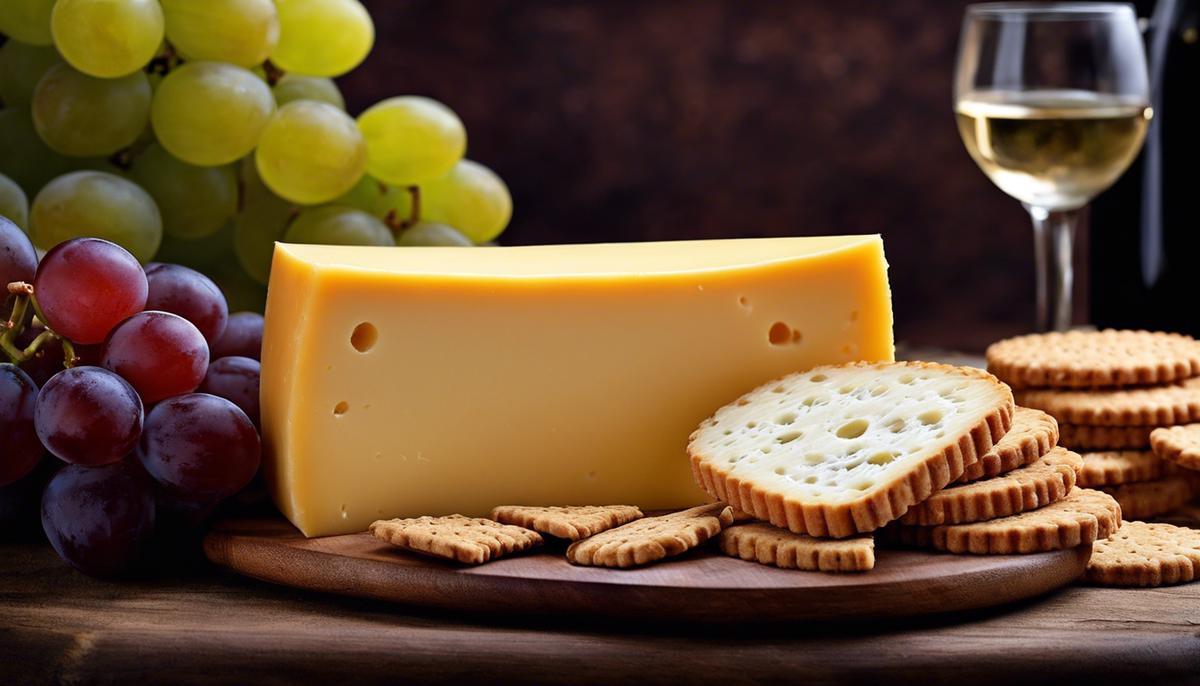
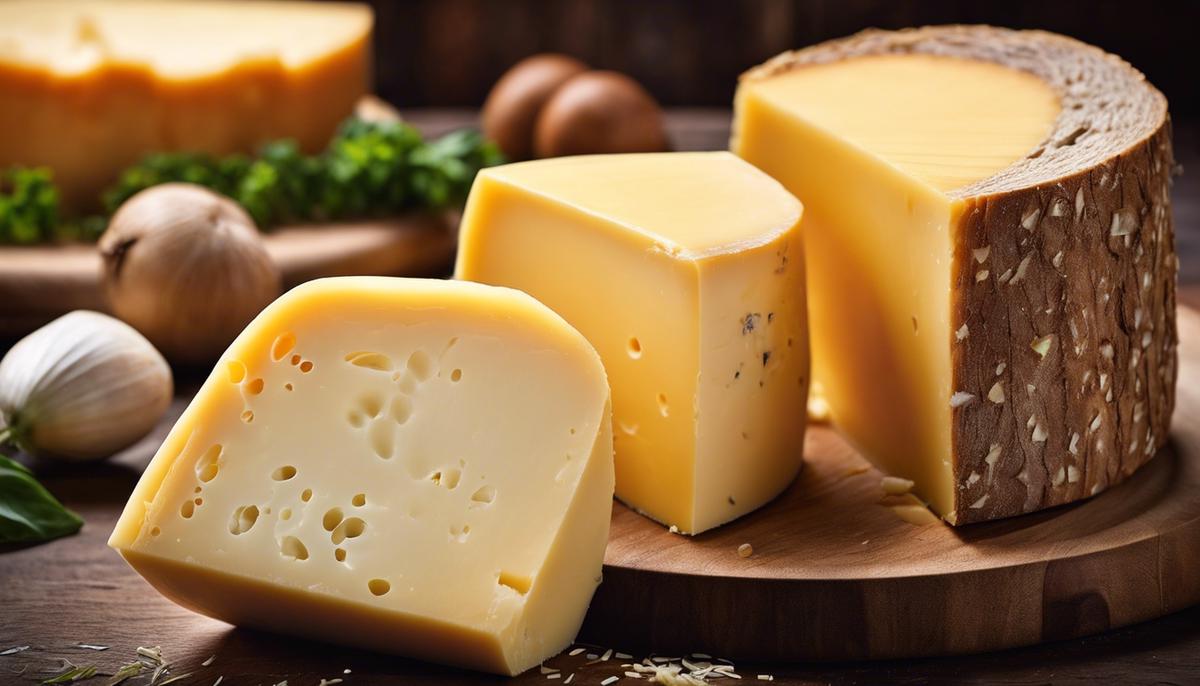
Nutritional Components of Gouda Cheese

Health Benefits and Risks Associated with Gouda Consumption

Comparison of Gouda Cheese with Other Cheese Varieties
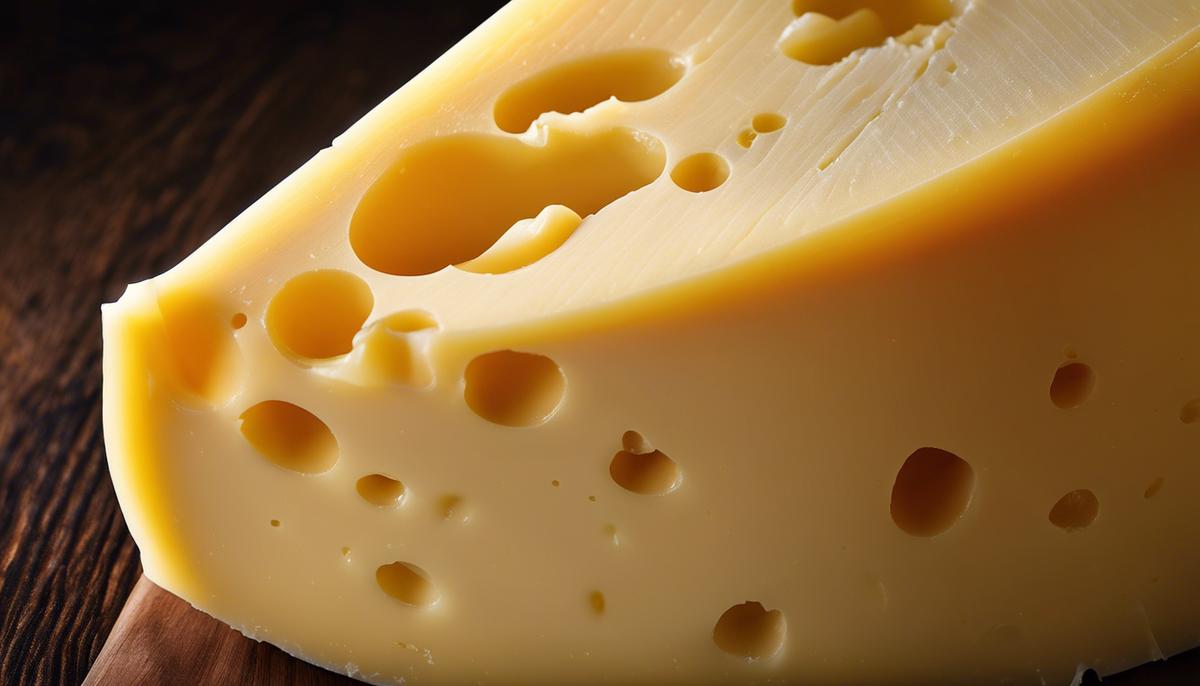
Dietary Considerations for Gouda Cheese Consumption
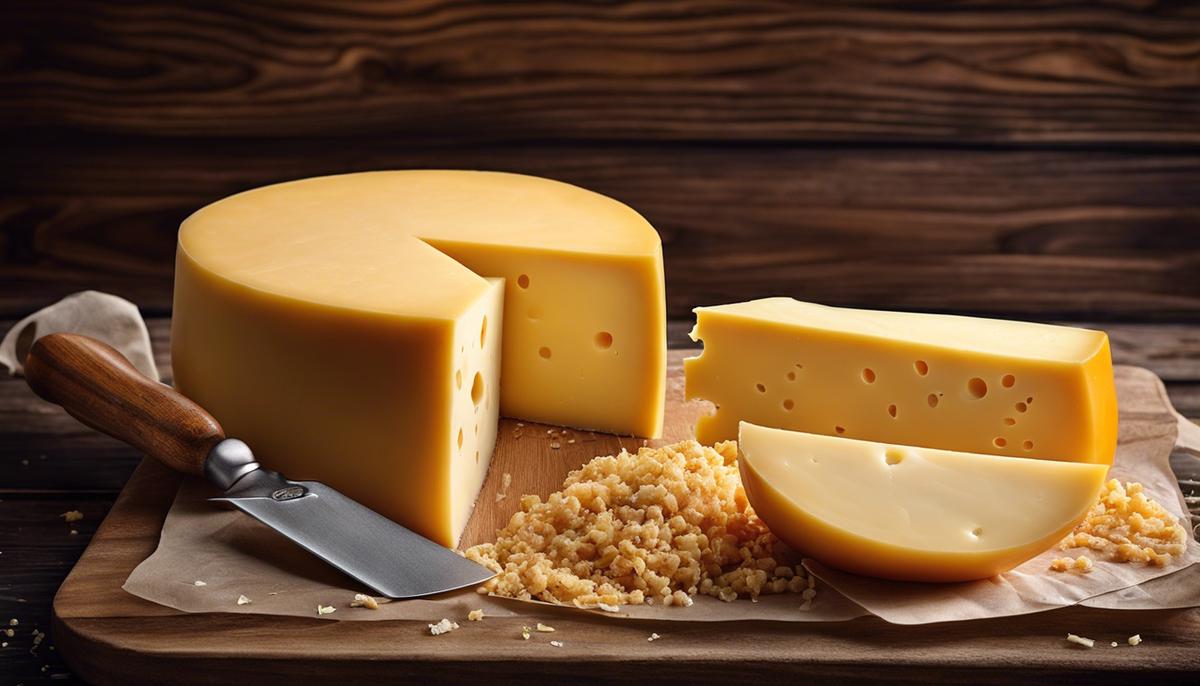
Gouda Cheese Process
Origins and Background of Gouda Cheese
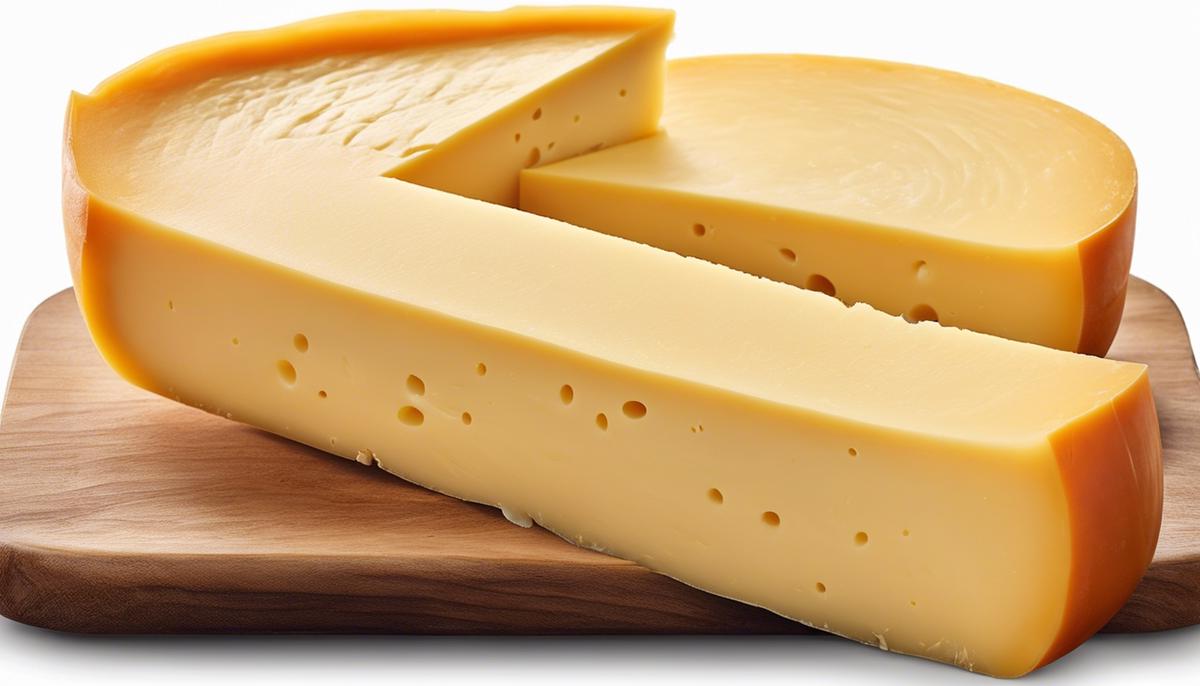
Chemistry of Gouda Cheese Making
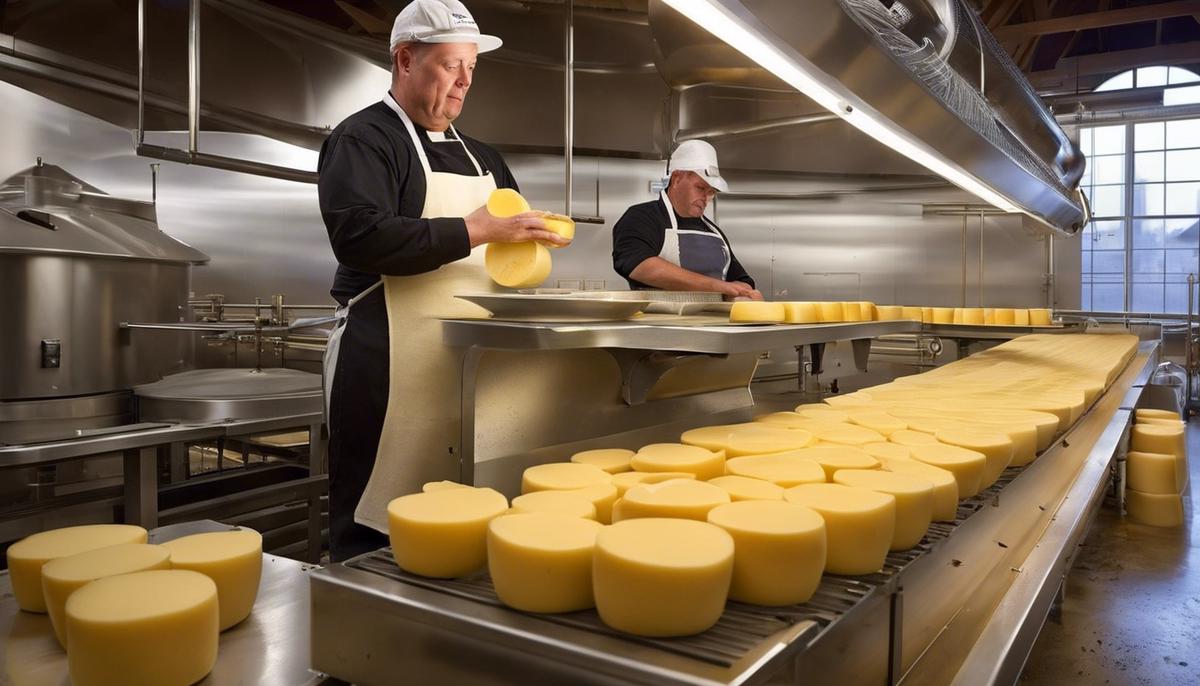
Quality and Nutritional Profile of Gouda Cheese

Environmental Impact and Sustainability in Gouda Cheese Production

Gouda Cheese Recipes
Understanding Gouda Cheese
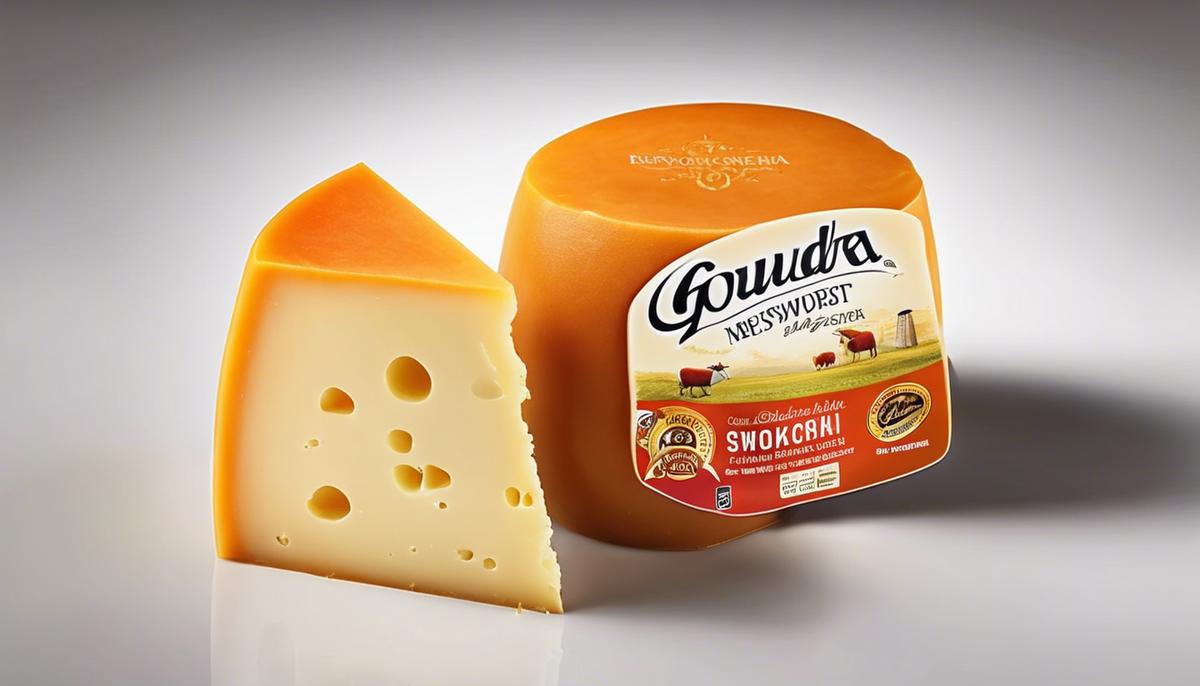
Recipe Selection | Gouda Cheese
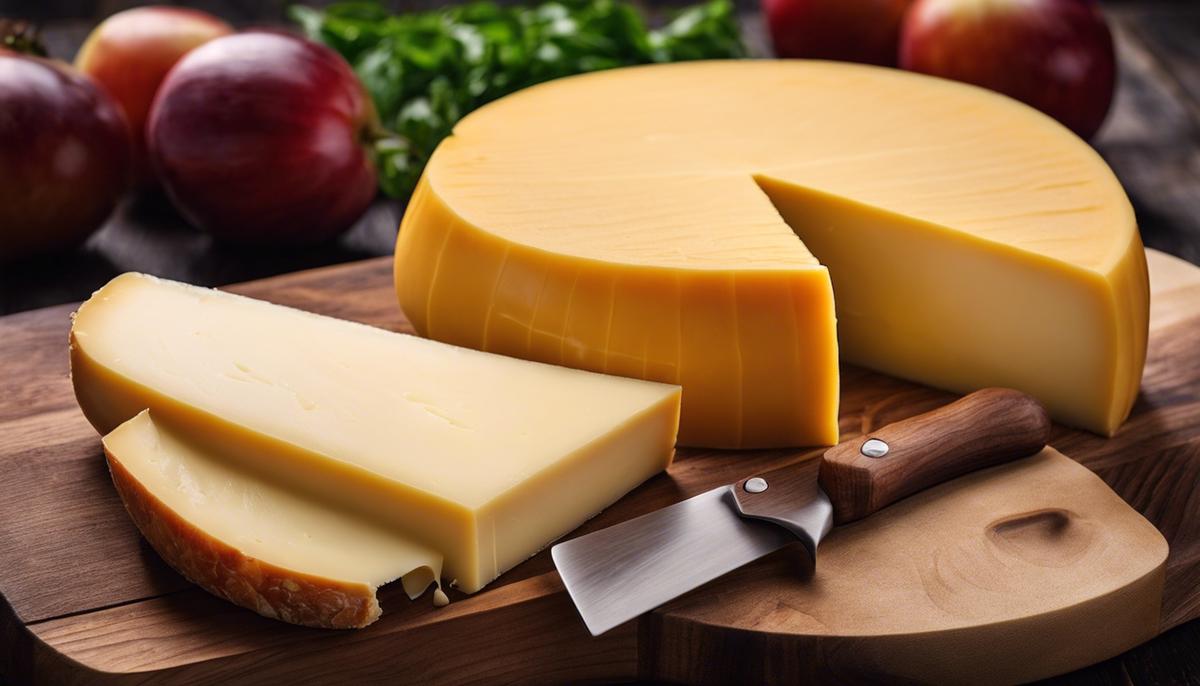
Culinary Techniques | Gouda Cheese
